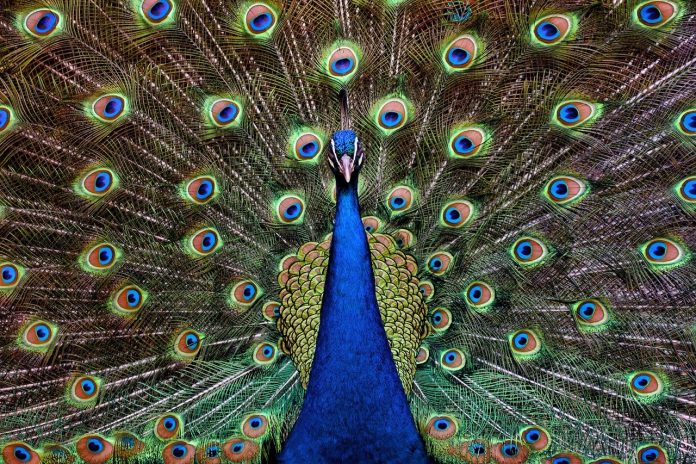The iridescent greens, blues and reds found throughout the animal and plant kingdoms are one of the most beautiful accidents of evolution. The striking colours found in a peacock’s feathers or painted on the exoskeleton of the jewel beetle are as a result of a phenomenon known as structural colouration. Working alongside pigmentation but separate in base, structural colouration has arises through random mutations in organism’s genome – altering the conformation of tiny cellular components like keratin and cellulose. The complex nanostructures which have been created range from helices to pockets and grooves. It is the varying ways by which these structures interact with light that causes these striking colours, resulting in the complex and beautiful examples we see across nature today.
What has been described as the “brightest biological substance” owes its intense blue appearance to this very same mechanism. Despite being over 40 years old and long dead , the fruits of Pollia condensate, known as the “Marble Berry”, cannot let go of their iridescent hue. This longevity is due to the fact that the colouration is caused not by degradable chemicals such as pigments, but by a microscopic landscape of cellulose microfibrils. In 2012 the thick walls of the fruit cells were found to contain cellulose helices, each layer rotated slightly more than the former. Blue light is selectively reflected, at up to 30 percent, due to the distance between most of the helices being the same as the wavelength of blue light. But the iridescence, with its subtle hints of red and green, is produced due to slight variations in this distance – reflecting small amounts of red, green and purple wavelengths.
Plants aren’t the only ones capable of iridescence. Structural colouration has evolved in the animals several times independently – including multiple times in insects, as well as in birds, fish, reptiles, cephalopods and at least once in mammals, in the Mandrill.
Hapalochlaena lunulata, the Greater Blue-Ringed Octopus, may have come to stardom when being used in the James Bond film Octopussy, but it was actually discovered and named over a century earlier in 1832. It is famous in-part for its relatively unique ability to change colour rapidly, a concept known as dynamic iridescence. When resting it appears a pale brown colour with faint blue rings, but when stressed it transforms as iridescent blue rings glow out against the brown.
The mechanism for this is based on pigment-containing cells called chromatophores, but even so they can be manipulated in a structural way. By coordination of the muscle and nervous systems the Octopus’ chromatophores can alter their physical size and shape, manipulating the way in which the light reflects off the pigment.

In the case of the Greater Blue-Ringed Octopus, colouration is used as a way of warning potential predators that they possess a powerful and paralysis-causing-neurotoxin, called tetrodotoxin, which can kill a human with a single one bite. However, structural colouration can also be used for communication, distraction and attraction. Pollia condensata berries draw in birds, with the sparkling blue flashing in the light as they fly towards it.
If one allows for generalisation, colour can be said to have evolved for different purposes in different groups. Birds often use it to assist with the task of finding a mate, whilst insects rely on chemical interactions, allowing them to instead use colour for camouflage – like in the distinctive morpho butterflies whose wings melt into the sky in ethereal swathes of blue as they fly overhead.
Structural colouration is thought to have evolved around 541 million years ago during a time known as the Cambrian explosion, yet the mechanisms and functions continue to change even in the present. The past century saw the emergence of the field of Biomimicry – the science of using biological processes as inspiration for new technology. The nanostructures controlling colour in butterfly wings and beetle exoskeletons are being used as the basis for new types of “never-fading” paints as replacements for toxic lead-based concoctions. These paints retain their colour for years, as they should: 49-million-year-old beetle fossils that have been unearthed still possess the same iridescent glow. This reflects just how important it is to understand the mechanisms of biology, not only out of respect for our wildlife’s incredible diversity, but also in an effort to make improve our societies by taking inspiration from biological innovation.
For Cherwell, maintaining editorial independence is vital. We are run entirely by and for students. To ensure independence, we receive no funding from the University and are reliant on obtaining other income, such as advertisements. Due to the current global situation, such sources are being limited significantly and we anticipate a tough time ahead – for us and fellow student journalists across the country.
So, if you can, please consider donating. We really appreciate any support you’re able to provide; it’ll all go towards helping with our running costs. Even if you can't support us monetarily, please consider sharing articles with friends, families, colleagues - it all helps!
Thank you!



